Report 4-Concepts of Color in Four Asian Countries - Gender & Colors

Analysts:Prae Pathanasethpong, INTAGE Inc. Takashi Inaba, Nippon Color & Design Research Institute Inc.
Overview
- The top colors selections for "Masculine" and "Feminine" were "Black" and "Pink," respectively. The top selections for "Childlike" colors were more variable, tending towards light tones in various color phases.
These results were common among the four Asian countries surveyed.
Analysis
1. "Masculine," "Feminine," and "Childlike" Colors: Results for all the four countries in total
Respondents chose dark colors, most often "Black," for "Masculine"; pinkish colors for "Feminine"; and light and soft colors such as "Rose Pink," "Canary Yellow," and "Orange" for "Childlike." These results were common among all four of the countries surveyed.
The chart in Figure 1 shows the top 10 colors considered "Masculine," "Feminine," and "Childlike" in the four countries totaled together. Respondents selected dark colors such as "Black" and "Dark Mineral Blue" for "Masculine"; pinkish and reddish colors such as "Pink," "Baby Pink," and "Red Purple" for "Feminine"; and chromatic colors in light tones for "Childlike." The trends favored color categories over specific colors: dark colors in general far outnumbered "Black" specifically for "Masculine," and pinkish, reddish colors in general far outnumbered "Rose Pink" specifically for "Feminine." The responses for color phases varied considerably.
[Figure 1] Top 10 colors considered "Masculine," "Feminine," and "Childlike" in the four countries in total (MA)
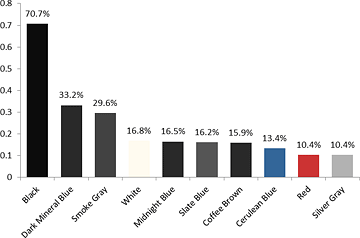
Top 10 colors considered "Masculine" in the four countries in total
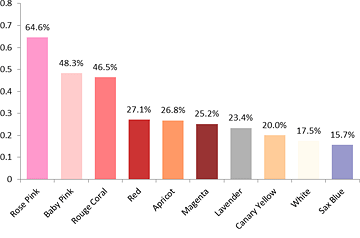
Top 10 colors considered "Feminine" in the four countries in total
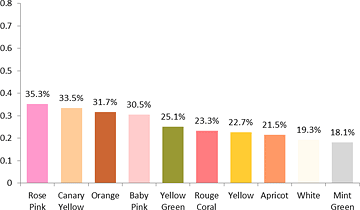
Top 10 colors considered "Childlike" in the four countries in total
2. "Masculine" Colors: Comparison by Country
The Japanese associate masculinity with bluish colors such as "Dark Mineral Blue," "Cerulean Blue," and "Midnight Blue." In China, Thailand, and Vietnam, high percentages of respondents selected "White." The Thais also frequently selected "Red."
Figure 2 shows the top five colors chosen as "Masculine" in each country. "Black" ranked at the top in every country. As the figure shows, people have a relatively similar color image for "Masculine" colors.
Focusing on the differences by country, more Japanese selected bluish colors, while the Chinese, Thais, and Vietnamese often selected "White," a color ranked fairly low in Japan. Relatively many people in Thailand selected "Red" as "Masculine."
[Figure 2] Top 5 "Masculine" colors: by country (MA)
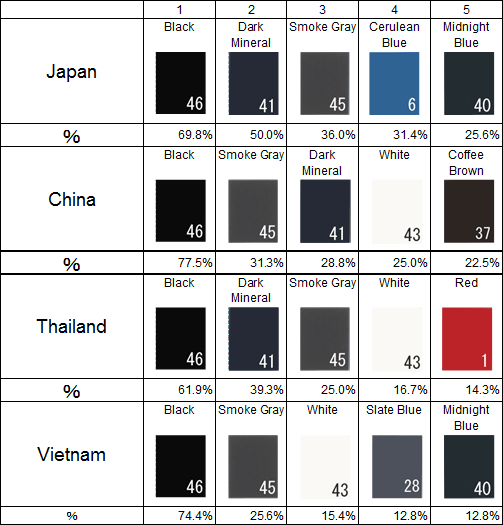
- * Sample numbers from the questionnaire color panel are printed directly over the colors.
3. "Feminine" Colors: Comparison by Country
"Pink" ranked at the top for "feminine" in every country surveyed.
Figure 3 shows the top five colors chosen as "Feminine" by country. As seen in the results for "Masculine," no major differences were found among the four countries in the selections for "Feminine. The colors selected were relatively similar.
"Pink" ranked at the top in every country surveyed.
Country by country, "Red" and "Magenta" ranked high in China, while "Lavender" and "Canary Yellow" ranked high in Vietnam. Pinkish colors were commonly selected in all four countries, but the color phases varied to some degree.
[Figure 3] Top 5 "Feminine" colors: by country (MA)
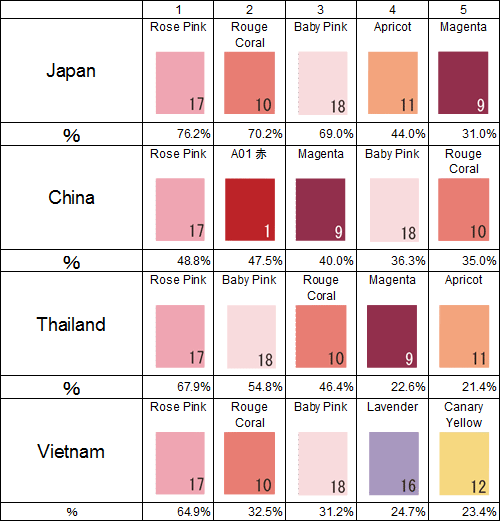
- * Sample numbers from the questionnaire color panel are printed directly over the colors.
4. "Childlike" Colors: Comparison by Country
Chromatic colors in light tones were selected as "Childlike" in every country surveyed.
The color phases, however, tended to vary.
According to the results for "Childlike" colors in Figure 4, chromatic colors in light tones were chosen in every country, but the color phases tended to vary. Country by country, "White" ranked much higher in Thailand and Vietnam, possibly because "White" represents the purity and innocence of children.
[Figure 4] Top 5 "Childlike" colors: by country (MA)
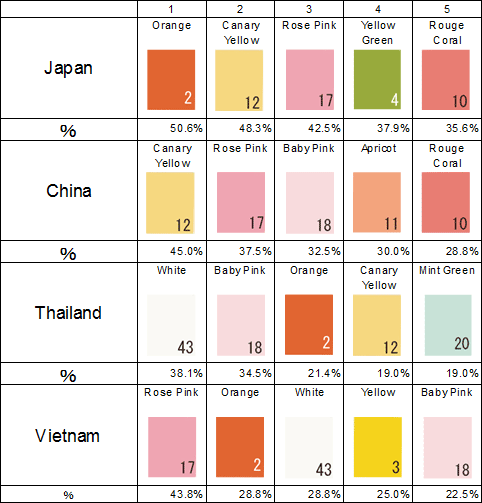
- * Sample numbers from the questionnaire color panel are printed directly over the colors.
5. Image Types associated with "Masculine," "Feminine," and "Childlike" colors: Results for the four countries in total
"Masculine" colors: COOL & HARD Zone
"Feminine" and "Childlike" colors: Warm & Soft Zone in common
To seek out the Color Types associated with "Masculine," "Feminine," and "Childlike," colors with survey rankings of 25% or higher were mapped out on a Color Image Scale.* The results are shown in Figure 5.
"Feminine" and "Childlike" colors are mainly located in the WARM & SOFT Zone and share color characteristics. The "Childlike" colors tended to be softer, however, and to vary more widely in color phases.
- * Color Image Scale This is a scale independently developed by Nippon Color & Design Research Institute Inc. to indicate common feelings people have about specific colors, based on accumulated psychological research. In the basic image scales, single colors or color combinations representing words (adjective or adjectival verb) are mapped out on two coordinate axes (a WARM - COOL axis and SOFT - HARD axis) selected as criteria for judging color images.
[Figure 5] Image Types associated with "Masculine," "Feminine," and "Childlike" colors (in the four countries in total)
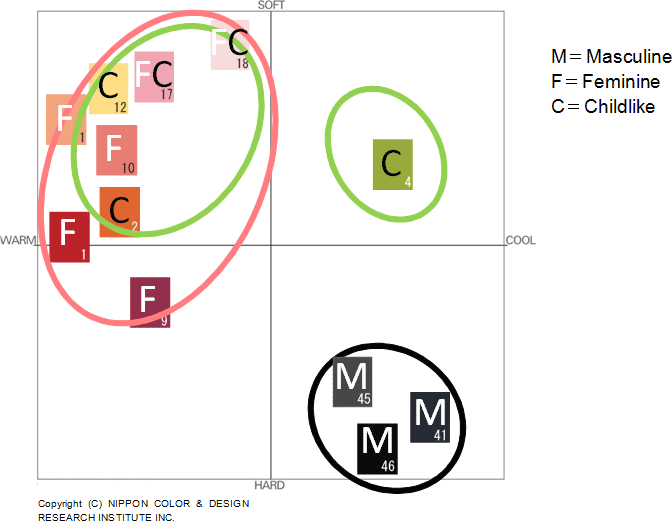
Survey Overview
| Survey Method | Self-administered questionnaire survey (with an accompanying panel of color samples) |
|---|---|
| Survey Area | Japan, China, Thailand, and Vietnam |
| Respondents | Males and females, aged 20 to 59 |
| Survey Samples | Japanese (Male 44: Female 43), Chinese (Male 40: Female 40), Thai (Male 42: Female 42) and Vietnamese (Male 40: Female 40) |
| Survey Period | January 2013 to April 2013 |
| Organizations Conducting the Survey | INTAGE Inc. and its overseas subsidiaries |
- * The survey results were analyzed jointly by INTAGE Inc. and Nippon Color & Design Research Institute Inc.
Asia Insight Report
INTAGE Inc. publishes the "Asia Insight Report" based on spontaneous surveys conducted in the Asian region in collaboration with overseas INTAGE subsidiaries to identify trends in attitudes and behavior on various themes.
Part 4 of the Report, "Color Image Survey in Four Asian Countries - Masculine, Feminine, and Childlike Colors," was analyzed jointly with Nippon Color & Design Research Institute Inc. The survey was conducted in Japan, China, Thailand, and Vietnam from January 2013 to April 2013. About 80 males and females (aged from 20 to 59) in each country were asked to fill out a self-administered survey questionnaire using a panel of color samples. The survey results follow below.
Nippon Color & Design Research Institute Inc.
Nippon Color & Design Research Institute Inc. (Head Office: Bunkyo-ku, Tokyo; Date of Establishment: January 20, 1967; President: Naoki Miyaoka) provides information based on psychological research on color designs and consumer tastes to many corporations and organizations in various industries (manufacturing, retail distribution, advertisement, construction, etc.), as well as the public sector. The company’s independently developed "Hue & Tone" system and "Color Image Scale" are widely used in various fields for color planning, marketing, and color design strategies.
